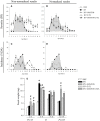Supplementation With 2'-FL and scGOS/lcFOS Ameliorates Rotavirus-Induced Diarrhea in Suckling Rats
- PMID: 30406046
- PMCID: PMC6205980
- DOI: 10.3389/fcimb.2018.00372
Supplementation With 2'-FL and scGOS/lcFOS Ameliorates Rotavirus-Induced Diarrhea in Suckling Rats
Abstract
Rotavirus (RV) is considered to be the most common cause of gastroenteritis among infants aged less than 5 years old. Human milk bioactive compounds have the ability to modulate the diarrheic process caused by several intestinal pathogens. This study aimed to evaluate the potential protective role of a specific human milk oligosaccharide, 2'-fucosyllactose (2'-FL), a mixture of the prebiotic short-chain galacto-oligosaccharides and long-chain fructo-oligosaccharides 9:1 (GOS/FOS) and their combination (2'-FL+GOS/FOS) on RV-induced diarrhea in suckling rats. The nutritional intervention was performed from the second to the sixteenth day of life by oral gavage and on day 5 an RV strain was orally administered to induce infection. Fecal samples were scored daily to assess the clinical pattern of severity, incidence and duration of diarrhea. Blood and tissues were obtained at day 8 and 16 in order to evaluate the effects on the epithelial barrier and the mucosal and systemic immune responses. In the assessment of severity, incidence and duration of diarrhea, both 2'-FL and GOS/FOS displayed a beneficial effect in terms of amelioration. However, the mechanisms involved seemed to differ: 2'-FL displayed a direct ability to promote intestinal maturation and to enhance neonatal immune responses, while GOS/FOS induced an intestinal trophic effect and an RV-blocking action. The combination of 2'-FL and GOS/FOS showed additive effects in some variables. Therefore, it could be a good strategy to add these compounds in combination to infant formulas, to protect against human RV-induced diarrhea in children.
Keywords: 2′-FL; diarrhea; prebiotic; rotavirus; scGOS/lcFOS; suckling rats.
Figures






Similar articles
-
Oligosaccharides Modulate Rotavirus-Associated Dysbiosis and TLR Gene Expression in Neonatal Rats.Cells. 2019 Aug 11;8(8):876. doi: 10.3390/cells8080876. Cells. 2019. PMID: 31405262 Free PMC article.
-
A combination of scGOS/lcFOS with Bifidobacterium breve M-16V protects suckling rats from rotavirus gastroenteritis.Eur J Nutr. 2017 Jun;56(4):1657-1670. doi: 10.1007/s00394-016-1213-1. Epub 2016 Apr 25. Eur J Nutr. 2017. PMID: 27112962
-
A fermented milk concentrate and a combination of short-chain galacto-oligosaccharides/long-chain fructo-oligosaccharides/pectin-derived acidic oligosaccharides protect suckling rats from rotavirus gastroenteritis.Br J Nutr. 2017 Jan;117(2):209-217. doi: 10.1017/S0007114516004566. Epub 2017 Feb 7. Br J Nutr. 2017. PMID: 28166850
-
Stool characteristics of infants receiving short-chain galacto-oligosaccharides and long-chain fructo-oligosaccharides: a review.World J Gastroenterol. 2014 Oct 7;20(37):13446-52. doi: 10.3748/wjg.v20.i37.13446. World J Gastroenterol. 2014. PMID: 25309075 Free PMC article. Review.
-
Impact of dietary fibers in infant formulas on gut microbiota and the intestinal immune barrier.Food Funct. 2020 Nov 18;11(11):9445-9467. doi: 10.1039/d0fo01700k. Food Funct. 2020. PMID: 33150902 Review.
Cited by
-
Human Milk Oligosaccharides Impact Cellular and Inflammatory Gene Expression and Immune Response.Front Immunol. 2022 Jun 29;13:907529. doi: 10.3389/fimmu.2022.907529. eCollection 2022. Front Immunol. 2022. PMID: 35844612 Free PMC article.
-
Exploring the Impact of Extra Virgin Olive Oil on Maternal Immune System and Breast Milk Composition in Rats.Nutrients. 2024 Jun 6;16(11):1785. doi: 10.3390/nu16111785. Nutrients. 2024. PMID: 38892716 Free PMC article.
-
Maternal diet shapes infant microbiota and defensive capacity against infections in early life via differential human milk composition.EBioMedicine. 2025 Aug;118:105850. doi: 10.1016/j.ebiom.2025.105850. Epub 2025 Jul 29. EBioMedicine. 2025. PMID: 40737758 Free PMC article.
-
Immunomodulation of B Lymphocytes by Prebiotics, Probiotics and Synbiotics: Application in Pathologies.Nutrients. 2023 Jan 5;15(2):269. doi: 10.3390/nu15020269. Nutrients. 2023. PMID: 36678140 Free PMC article. Review.
-
Maternal Synbiotic Supplementation with B. breve M-16V and scGOS/lcFOS Shape Offspring Immune Development and Gut Microbiota at the End of Suckling.Nutrients. 2024 Jun 15;16(12):1890. doi: 10.3390/nu16121890. Nutrients. 2024. PMID: 38931246 Free PMC article.
References
-
- Akbari P., Fink-Gremmels J., Willems R. H. A. M., Difilippo E., Schols H. A., Schoterman M. H. C., et al. . (2017). Characterizing microbiota-independent effects of oligosaccharides on intestinal epithelial cells: insight into the role of structure and size. Structure–activity relationships of non-digestible oligosaccharides. Eur. J. Nutr. 56, 1919–1930. 10.1007/s00394-016-1234-9 - DOI - PMC - PubMed
-
- Arévalo Sureda E. A., Weström B., Pierzynowski S. G., Prykhodko O. (2017). Maturation of the intestinal epithelial barrier in neonatal rats coincides with decreased FcRn expression, replacement of vacuolated enterocytes and changed blimp-1 expression. PLoS ONE 11:e0164775. 10.1371/journal.pone.0164775 - DOI - PMC - PubMed
Publication types
MeSH terms
Substances
LinkOut - more resources
Full Text Sources
Other Literature Sources
Medical

